Abstract
This paper presents the experimental study results on the effect of heat flux emitted by a standard source on the charring and ignition characteristics of wood construction materials (plywood, chipboard, and oriented strand board) using infrared thermography (IRT) in the narrow spectral ranges of infrared wavelength. The time to ignition (TTI), charring rate and depth were obtained for the samples. In addition, the effect of several fire retardants on the charring rate and depth of the samples and TTI was analyzed. All fire retardants contribute to an increase in TTI, which confirms their main function—fire protection. However, the effect of fire retardants differs noticeably depending on the material. A new experimental technique is suggested, with the infrared imaging of the temperature distribution along the end of a sample under the heat flux effect on its frontal surface. The uniqueness of this approach consists in the registration of the entire process of ignition and combustion of the presented materials, which occurs in real time without contact with high spatial and temporal resolution. Using the infrared camera of the research class, it becomes possible to record the entire process from the occurrence of the temperature exposure region to the deep carbonized crater in the body of the material. The results can serve as additional recommendations in the development of fire hazard testing methods for construction materials and fire retardants.
1. Introduction
A huge amount of heat is released during the propagation of the ground and crown fires which can cause the firing of wood constructions in the settlements located close to the forest border. It is noteworthy that the frontal fireline intensity may vary by more than 1000-fold from approximately 15 to at least 100,000 kW/m, mostly due to the potential variation in the rate of fire spread [1]. There are several reasons for an increasing number of wildland fires in Russia. The first reason is related to the long forest ranges resulting in an increased risk of fire. The second one consists in an incomplete understanding of the physics of natural processes, in particular the wildfire spread to buildings and constructions. To ensure the required level of fire safety, continuous extensive measures are taken, such as personnel training, the development of fire extinguishing methods and activities, monitoring and forecasting of fires, and the improvement of experimental and educational facilities of research institutions, etc. Despite all the significant efforts conducted to prevent fire hazards, the annual number of fires remains quite high.
Aseeva et al. [2] emphasized that there is much in common between the patterns of initiation and propagation regularity of wildfires and the fires in buildings and constructions made of wood construction materials. The similarity is attributed to an organic nature of the forest fuel and wood materials. The issues related to the effects of forest and mixed fires are discussed in [3,4,5,6]. It was concluded that the losses of convection heat and heat emission during the fire spread in closed premises are retained by walls. Moreover, a certain humidity is maintained in closed premises while in forests, the humidity is determined in accordance with environmental attributes such as precipitation, season, solar radiation, and wind. In addition, oxidizer inflow into closed premises is limited; an opposite situation is observed in forests [7].
Studying the effect of wildfires on the wood constructions by performing the large-scale field experiments is complicated due to low experimental reproducibility and a great dependence of experimental conditions on external factors [8,9,10,11,12]. Generally, the mentioned problems are solved in laboratory conditions, which make it possible, with some assumptions, to partially simulate the conditions of the wildfire effect on the samples made of wood.
In construction engineering, softwood is usually used as a load-bearing structure, and hardwood is used as a finishing material. One of the factors determining the fire behavior of wood is its capacity to ignite and to stimulate fire propagation. Grishin [4] emphasizes the main physico-chemical processes occurring during wood combustion, including heating from a wildfire front due to convection and radiation, drying, pyrolysis, the formation of condensed, gaseous and dispersed pyrolysis products, followed by burning. As a result, a convective column appears above the seat of fire of wood and contains dispersed particles (coke and soot particles) and gaseous products of wood combustion. This fact makes the problem of mathematical physics more complex.
In the literature, there is a great number of experimental studies on the fire behavior of wood and wood-based products, which provide evidence of the influence of various factors on the flammability and fire behavior of wood, such as the species and types of wood, the conditions and time of its use, the moisture content, the fire intensity, etc. A detailed discussion of the problem is presented in [2,9,13,14,15,16,17,18,19,20,21,22,23]. On the basis of the obtained data, it is currently possible to assess the fire resistance of wood constructions. However, in most cases, the thermal analysis and flammability assessment techniques including thermogravimetric (TG) analysis, cone calorimetry and the single burning item test are utilized to study the fire behavior of wood.
With the progress in the chemical industry, the fire retardant agents have been developed that, depending on the class and intensity of fire, partially or completely prevent the ignition of the processed surfaces [24,25,26]. The fire-proof efficiency is determined on the mass losses of material processed with fire retardant under normal study conditions. The sample is exposed to the flame of the gas burner for 40 seconds [27]. These data are indicated in the fire retardant recommendations. There are many analogues in building with their particular technical parameters, consumption, degree of toxicity, as well as price category.
It was noted in [2] that the fire retardant slabs, the fire-resistant materials of roll type, and the superficial and deep impregnation with specific fire retardants, as well as fire retardant coatings, are widely used for fire-protection in buildings and constructions with bearing and enclosing structures made of timber. The most commonly used methods to evaluate the fire retardant performance of wood materials include thermogravimetric analysis, differential thermal analysis (DSC), cone calorimetry, lateral ignition and flame spread test (LIFT), and large scale calorimetry, such as the single burning item (SBI) test [25]. Some results in a study of fire retardant’s effect on a wood flammability are presented in [2,24,25,26,28,29,30]. Aseeva et al. [2] emphasized the limited data in an experimental study of the effect of fire retardant coatings on the fire resistance rating of wood constructions, which confirms the relevance of work in this field.
It is noteworthy that the literature still lacks results on the use of noncontact optical methods of high accuracy grade during the tests on fire resistance of wood constructions and construction materials. In the work [31] on the study of the radiant smoldering ignition of plywood, the optical pyrometer used to determine the temperature on the surface of a test sample exposed to heat fluxes of different intensity does not provide a technical description of the pyrometer, which does not allow one to use these data for comparison. Various thermal analysis and flammability assessment techniques including thermogravimetric analysis, cone calorimetry, and the single burning sample test are used to study the fire behavior of wood. Contact sensors for temperature and heat fluxes, which introduce some error during the measurement, are widely used in most of them.
Infrared thermography (IRT) is a remote method to determine the temperature field based on the recorded radiation in the infrared wavelength range. The use of narrow-band filters in the medium wave IR range seems to be a promising approach to determine the temperature fields in the flame, considering that during the flame combustion of various forest fuels, volatile pyrolysis products and gaseous combustion products make a significant contribution to flame radiation. In particular, the emission spectra of the flame formed during the combustion of forest fuels, as well as the results of radiation studies from the fire front at the wavelengths of 3.6, 4.8, and 4.2 μm, are presented in [32]. The work [33] presents the emission spectra and characteristics of IR measurements for various gases, including water vapor and carbon dioxide heated to 2000 K, which are the main combustion products. Experimental results are presented in [34,35,36] on the determination of the flame radiation properties formed during the combustion of forest fuels. It is noteworthy that these works present the results for the close IR range and the initial part of the middle IR range, where high emission bands of combustion products begin to appear. These results confirm the need for the accurate choice of the spectral interval for solving various problems, such as obtaining a well detailed temperature field in a flame or recording objects that the flame screens. Modern infrared cameras allow one to operate in the wavelength ranges from 2 to 5 μm, where the main high emission bands are. At the same time, it is possible to perform selective recording using narrowband filters.
Currently, the modern methods of IR diagnostics [37,38,39,40,41] are being widely used to study combustion behavior and wildfires. It is noteworthy that in the literature there is still a lack of the results on the use of noncontact methods during the tests of wood constructions and construction materials for fire resistance. In particular, the data obtained by Grishin et al. [9], Vermesi et al. [19] and Loboda et al. [42] present the experience of a noncontact method using for temperature measurement in the laboratory and during field fire tests of building parts and constructions made of wood.
Infrared technology (IRT) has found a wide use in the analysis of the structural properties of structures made of wood material. A method for determining the defects or gaps in wooden structures using IRT is considered in [43,44,45,46]. The authors in [47] used an original approach to assess the density of wood by changing the surface temperature of the preheated wood sample. The study of the wood radiative properties is carried out in [48,49]. The influence of various fire retardants on the fire behavior of softwood and hardwood were experimentally analyzed using the IR diagnostics in [50,51]. Some recommendations were made on the use of thermography during the testing of wood and construction materials for fire behavior and fire protection [52]. However, the available data require additional experiments to be carried out to study the characteristics of fire behavior of various construction materials utilizing the IR diagnostics.
Based on these data, the development of the testing technique of various wood constructions for fire behavior and fire protection using thermography allows one to reduce economic expenditures for such works. At the same time, this will lead to an increase in the efficiency of data generation and resolving power.
This article presents the investigation results concerning the effect of heat flux from a standard source on the charring and ignition characteristics of wood construction materials using the IR diagnostics. A new method of setting the experiment geometry (with a specific arrangement of equipment) with the recording of an IR image of the temperature distribution along the end of the studied sample under the heat flux effect on its frontal surface was proposed. Furthermore, the influence of several fire retardants on the charring rate of the wood samples as well as the ignition delay were analyzed.
2. Materials and Methods
To estimate the charring rate resulting from the heat exposure in laboratory conditions, the laboratory facilities presented in Figure 1 were arranged.
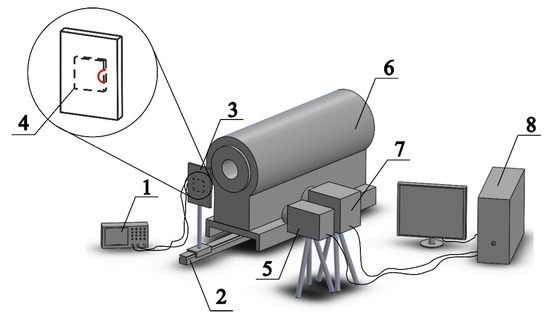
Figure 1.
Installation diagram scheme: 1—Tektronix TDS-1002 oscilloscope (125 × 151 × 324 mm); 2—optical rail (60 × 50 × 1000 mm); 3—carriage with prop (200 × 250 × 18 mm); 4—the wood sample (100 × 100 × 18 ÷ 21 mm) and the heat exposure area applied to it; 5—Canon HF R88 video camera (53 × 58 × 116 mm); 6—blackbody model (200 × 340 × 800 mm); 7—JADE J530SB infrared camera (122 × 153 × 314 mm); 8—personal computer (152 × 430 × 432 mm).
Experimental equipment involves the following devices: a scientific infrared camera JADE J530SB equipped with an optical filter whose operating wavelength is of 2.5–2.7 μm which allows one to record the temperature in the range of 300–800 °C; a video camera Canon HF R88 applied for estimating the ignition delay for considered samples made of wood construction materials; a blackbody 45/100/1100 of the Omsk plant OJSC RPA "Etalon" with a temperature variation range of 100–1100 °C which serves as a blackbody simulating an infrared source, with an emission rate close to unity and the aperture is 45 mm; a heat flux sensor Hukseflux SBG01 with an operating range of 0–100 kW/m2; an oscilloscope Tektronix TDS-1002 applied to measure a energy-dispersive specter occurring when using type K thermocouples; a moisture content analyzer AND MX-50 for controlling the moisture content of the studied samples. The matrix size of the IR camera is 320×240 pixels. The frame rate of IR-shooting is 5 frames per second.
The narrowband optical filter was chosen on the basis of Planck’s law for blackbody density. This can be explained by the fact that the charred layer of wood materials is close in its optical properties to the blackbody. Therefore, the Plank curve (Figure 2) corresponding to a temperature of 1100 °C is plotted in accordance with Equation (1):
where is the radiation power emitted by a blackbody surface unit in the unit interval of wavelength, h is the Planck constant, k is the Boltzmann constant, c is the speed of light, and T is the absolute temperature of blackbody [48]. Based on Figure 2, it can be concluded that the use of a narrowband filter allows recording the infrared radiation of the highest intensity for the specified temperature of blackbody. Applying the optical filter with an operating spectral band of 2.5–2.7 micron makes it possible to eliminate the impact of the absorbing properties of carbon dioxide emitted during the combustion process (the maximum absorption line for CO2 is generally observed in the 4.3–4.6 micron wavelength band).
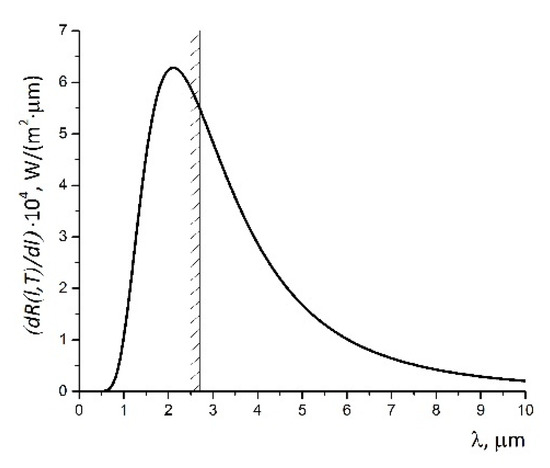
Figure 2.
The calculated Planck curve corresponding to a temperature of 1100 °C, with a selected working spectral band of 2.5–2.7 micron.
Plywood, chipboard, and oriented strand board (OSB) are used as samples of wood construction materials which are popular in building. The main parameters of the samples are presented in Table 1.

Table 1.
Parameters of the samples.
The following retardants were employed as a fire-bio retardant treatment for wood: “ZOTEKS Biopirol”, “Fenilaks”, “FUKAM”, which are also used for sawn, planed, and logged construction elements for home, public, industrial, and agricultural purposes. The consumption of the retardants, which ensures group II fire resistance effectiveness according to the technical regulations in [22], is chosen on the basis of manufacturer recommendations. The impregnation of the samples is implemented using retardant applied by brush and dried afterwards. A standard drying mode (40 °C during the day) was used, which provided the indefectible drying of wood without damaging strength characteristics. These conditions are recommended for drying wood for domestic consumption to any humidity level. It should be noted that surface impregnation, regardless of cheapness and manufacturability, is less effective in terms of fire retardant properties than deep impregnation [26]. However, this allows one to process wooden structures directly on construction sites.
Currently, a large number of fire retardant impregnating compositions for wood are created, which can differ from each other with various compositions and the quantitative combination of low molecular organic and inorganic compounds with the properties of fire retardants [25]. In particular, the “Fenilaks” composition contains carbonates, which are very effective as fire retardants in the gas phase. The most common substance on the basis of fire retardant composition is potassium carbonate, which is a compound with high fire retardant efficiency for wood materials [53,54]. It has a relatively high decomposition temperature of 800 °C and serves as a catalyst for the wood dehydration reaction to increase the production of char, water and CO2. However, this material cannot effectively prevent the reaction of wood polymerization, especially at high concentrations, and also causes the release of CO [53]. Thus, potassium carbonate is used in low concentrations only. Unfortunately, manufacturers of fire retardants “FUKAM” and “ZOTEKS Biolpirol” do not declare the composition of the fire retardant in the documentation, which makes it difficult to further study their fire retardant properties.
The experiment was carried out as follows. The studied sample was placed on the stand fixed on a movable carriage with a retainer which was installed on the optical rail (Figure 1). The sample was fixed on the holder using the flexible metal bracket (material is tin plate) in a way to minimize the metal–wood contact area, which in turn made it possible to eliminate the effect of heat sink [55]. The bracket was positioned relatively the sample, thus the distance from the main area of exposure of the blackbody model radiation would be as high as possible. Therefore, fixing the bracket to the back of the substrate was carried out using a screw connection. Furthermore, the carriage with the sample was arranged with a fixed gap opposite to the blackbody. Using the control unit, the temperature of blackbody was preliminarily set to 1100 °C, and the temperature regulation error was specified as 1 °C. The location of the sample and optoelectronic recording equipment with regard to the blackbody was chosen for the purpose of recording the heat flux effect at the end sample (Figure 3).
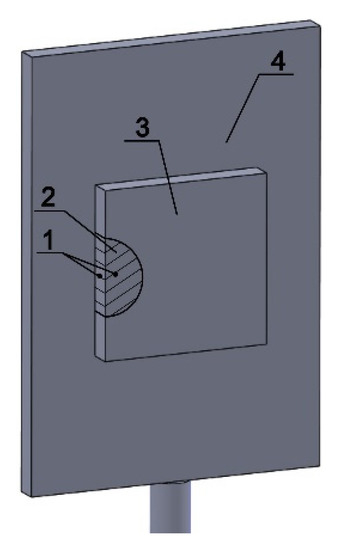
Figure 3.
The prop with the installed sample: 1—outlet for thermocouples; 2—influence area of the blackbody heat flux (diameter 45 mm); 3—wood sample (100 × 100 × 18 mm); 4—holder (200 × 250 × 18 mm).
Heat exposure lasted for 10 min. Three repetitions were performed for each experiment. Additionally, the thermocouple measurements were taken to control the sample surface temperature. Two type K thermocouples with a junction of 200 microns in diameter were installed into the studied sample; one junction was placed on the surface, and another was embedded by 3 mm. The use of thermocouples was reasoned exclusively for the operational monitoring (observation) of temperature during the experiments.
The addition investigation was carried out to determine the blackbody radiation density at different distances from its aperture. The heat flux sensor SBG01 was attached to the movable carriage (Figure 4).
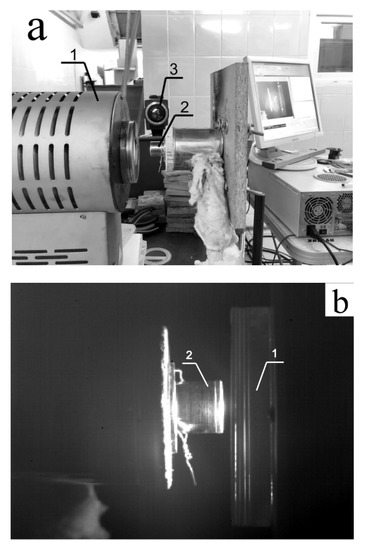
Figure 4.
Measurement of the heat flux from the blackbody: (a)—the experimental setup photograph; (b)—infrared image of the installed heat flux sensor SBG01: 1—output part of the blackbody; 2—measuring tool in Altair software controlling the spacing; 3—JADE J530SB infrared camera.
Moving the carriage with the sensor, thereby changing the distance between the blackbody and heat flux sensor, a signal was recorded using an oscilloscope. The obtained data were converted in accordance with the calibration of the manufacturing plant. As a result of measurements, the maximum heat flux density (Figure 5) with a gap of 1 mm was 40.1 kW/m2, and the maximum error between the approximating and experimental curves was 3.5%.
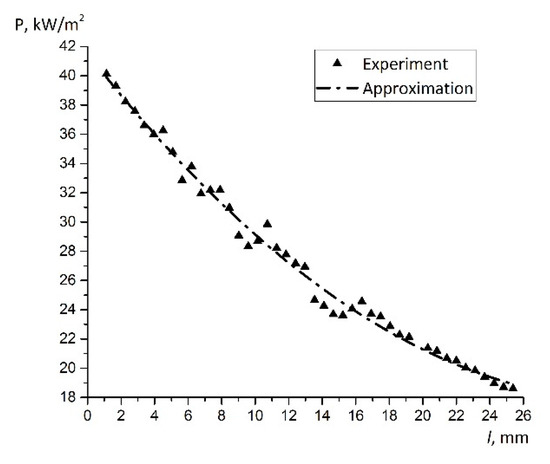
Figure 5.
The change in the heat flux depending on the distance between the sensor and the blackbody.
It is well known that the density and thermal properties of wood both have a great influence on the charring rate and ignition delay [2]. The maximum heat flux from the blackbody during the record was 37.5 kW/m2 at the temperature of 1100 °C. The lower limit was determined experimentally. Hence, the working value of the heat flux was in the range of 32–37.5 kW/m2 corresponding to the parameters for estimating the fire behavior of wood materials presented in the literature [13].
Additional experiments were carried out to study the heat flux during the combustion of various types of forest fuels that are common for boreal forests. The heat flux sensor SBG01 was used as a measuring device. The heat flux values are irregular in space and time in the case of exposure to an open flame source on the sample surface. Studies of the heat flux from a model ground fire show an average value of 36.6 kW/m2 (maximum is 51.3 kW/m2, where, in particular, pine needles, cedar needles, and also steppe fuels (fuel bed with a mass of 50 g) are used as a combustible material (Figure 6). Taking these values into account, the authors selected the optimal characteristics of the heat flux for work.
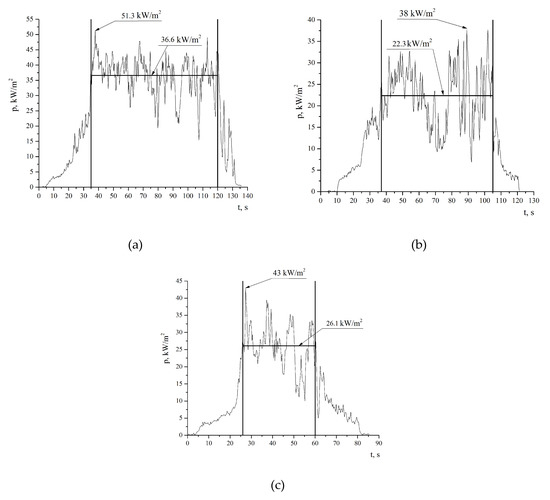
Figure 6.
Change in the total heat flux during the combustion of some types of forest fuels: (a) pine needles; (b) steppe fuel, (c) cedar needles.
The working value of the heat flux is in the range of 32–37.5 kW/m2, which corresponds to the parameters for assessing the fire behavior of wood materials presented in the literature [56]. The obtained values are included within the range of heat fluxes of 10–50 kW/m2, which are used for fire tests on construction materials, components and structures [56,57,58].
As a result of infrared camera recording, sequences of thermograms were obtained and then processed using the Altair software. To analyze the temperature versus time profile at the end of the sample, the following treatment was carried out. Knowing the size of the infrared camera matrix and the scale factor (a distance from the camera lens to the sample end), the boundaries of the sample were defined on the frame using the resulting thermogram (Figure 7). In order to obtain the temperature table for the considered sample, the temperature values corresponding to each pixel of the matrix were exported. Subsequently, the extra values were removed in accordance with previously obtained data on the sample position on the frame.
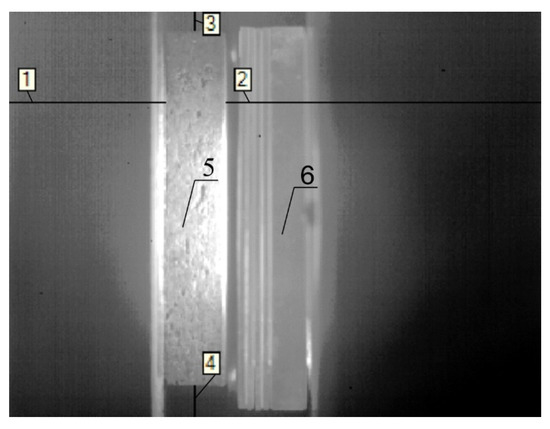
Figure 7.
Infrared image of the chipboard sample: (1–4)—installed measuring tools for determining position of the sample in the frame; 5—test specimen; 6—the blackbody.
3. Results
Figure 8 shows a typical sequence of thermograms of the smoldering front propagation in the case of a chipboard sample. The asymmetry in the temperature distribution at the end face of the sample is caused by the impact of the convective flow of heated gaseous combustion products.
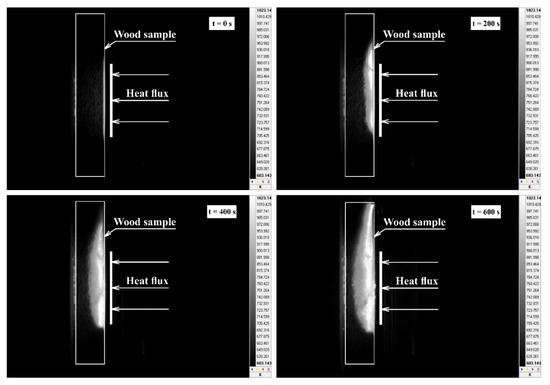
Figure 8.
Thermogram sequence of smoldering front propagation at the end of the chipboard sample.
The use of infrared diagnostics made it possible to assess the fire behavior of the studied samples of wood construction materials after heat flux exposure. The experimental data were processed using the Altair software. Knowing the characteristics of camera lens and the distance from lens to sample, the geometrical parameters were obtained. The char depth was determined during the processing of the thermogram obtained in the end of recording. The end of the studied sample in the initial time instant was taken as a reference point. In the vertical direction, the reference point was located in the central axis of the outer part of the blackbody. The charring rate was recorded every 100 s. The frequency of the infrared recording in the experiment was 5 frames per second. The total recording time was 600 s. As the result of the recording, one had a set of 3000 thermograms for analyzing the carbonization depth. The interval of 100 s was chosen based on the fact that there was a noticeable displacement of the carbonization boundary and the formation of a crater during this period. Knowing the variation in the charring depth during the specified time instant, the charring rate was calculated by the formula: νchar = lchar/t. The confidence intervals were calculated at the 95% credible level. The data presented in Table 2 (νchar are the charring rate and dchar is the charring depth).

Table 2.
Charring rate and depth of the considered samples of wood construction materials (average of 3 experiments) at a heat flux density of 34.7 kW/m2.
As a result of the studies performed using the thermocouples and infrared camera, a good agreement was obtained on the maximum temperature on the surface exposed to the heat effect. In particular, for the considered samples without using fire retardant impregnation, the average value of the surface temperature was 650 °C, while using the impregnation it was 820 °C. The surface temperature was controlled specifically, and the data were given for the smoldering mode without the flame. The average value was calculated based on the set of repetitions of similar experiments for all types of samples, which reflects the maximum surface temperature at the sample’s end during the experiment (10 min). The fundamental difference from the existing contact measurements is the direct control of the temperature range whereby active pyrolysis occurs. It was found that after processing material with fire retardant, the temperature range border of the active pyrolysis stage shifted without the appearance of flame combustion, which affected the ignition time and surface temperature. A similar temperature value in the near-surface layer of the sample more than 800 °C is described in [59], as well as the influence of fire retardants used on OSB boards on the fire resistance of entire light timber frame wall assemblies. Additionally, in [60], during the analysis of the TG and DSC curves, the temperature range of 810–930 °C was identified as a separate decomposition stage, whereby the combustion of char itself and its monoxide occurred.
To verify the experimental data obtained, a comparison with those from the paper [2], which summarizes the results on the average charring rate of hardwood and softwood depending on the intensity of external heat flux in the range of 10–40 kW/m2, was carried out. Due to the fact that the composition of the studied samples contains additional binding components (synthetic resins, etc.), the plywood was taken as the material having an almost similar composition with that of the birch mass, and the experimental results were compared with that obtained for other materials. The discrepancy between the results was 30%.
Analyzing the values of the charring rate obtained for the samples of wood materials processed by fire retardant, one can conclude that the “FUKAM” made the greatest contribution to the fire retardant properties in comparison with the sample without fire retardant (a decrease in the rate of carbonization by 18% for plywood and 25% for OSB). For the other fire retardants, there was a characteristic increase in the rate of carbonization by an average of 9% for plywood and 28% for chipboard. The increase in the carbonization rate for OSB was not significant (2%). In addition, the opposite effect was recorded in the effect of fire protection: increasing the charring rate for each type of wood material after its processing. In particular, the "Fenilaks" showed such properties for each material, which is consistent with the results of the work [22], which presents the results of fire tests of pine with the fire retardant composition “KSD-A” in a wide range of heat fluxes 10–50 kW/m2. The fact that the charring rate of the near-surface layer of wood was almost 3.5 times higher than untreated one was experimentally confirmed.
A comprehensive review of experimental and theoretical studies on factors affecting the burning behavior of different types of wood at heat fluxes between 5 and 60 kW/m2 is presented in [15]. An analysis of the charring rate versus incident heat flux for the constant heat flux tests straight in the range of heat flux values of 30–40 kW/m2 shows good agreement with the results of our work in the carbonization rates of the samples, with regard to the difference in the duration of heat exposure and the source itself (cone calorimeter and furnace tests, different radiant heating apparatus).
The time to ignition of the samples after heat exposure (q = 37.5 kW/m2) is presented in Table 3.

Table 3.
Time to ignition of the samples, fire retardants contribution assessment.
It should be emphasized that the surface impregnation provides a layer of fire protection on the surface, which does not exceed 2 mm. As the result of the carried out work, one can conclude that the standard brush impregnation recommended by the producer does not provide the required fire protection (fire protection consumption is 0.3–0.5 kg/m2).
The expected result was obtained after comparing the time to ignition (TTI) values for all samples of wood materials. All fire retardants contribute to an increase in TTI, which confirms their main function—fire protection. However, the effect of fire retardants differs noticeably depending on the material. Satisfactory fire retardant properties for all types of wood materials are shown using “FUKAM” (TTI increase by 87% for plywood, 51% for OSB and 25% for chipboard). “ZOTEKS Biopirol” and “Fenilaks” showed the best fire retardant properties for plywood (“ZOTEKS Biopirol” increased TTI more than two times, “Fenilaks” increased TTI by 65%), in comparison with the same material without fire retardant. However, the contribution for OSB is insignificant (“ZOTEKS Biopirol” increased TTI by 8%, “Fenilaks” increased TTI by 6%). Such differences for the OSB can be caused by the characteristics of the material structure (thin chips and binder material), which do not allow to qualitatively process the surface using a brush. The use of fire retardant can lead to a decrease in the time to ignition [30]. This effect is substantiated by the characteristics of the interaction of pyrolysis products and the fire retardant composition.
The use of the black body model as an emitter leads to the fact that the thermal effect is highly homogeneous, which differs from the standard methods and data available in the literature [15,61]. Currently, the authors are conducting experiments to study the effect of vacuum impregnation of wood on fire hazard indicators. The main advantage of deep impregnation over other processing methods is the penetration depth of the protective compounds. It can be from 5 to 50 mm, depending on the type of wood. Preliminary results show that the use of vacuum impregnation contributed to the high fire resistance of wood over the entire range of heat flux 10–40 kW/m2 from the emitter, which resulted in a decrease in the carbonization depth by more than two times in comparison with the similar material with surface treatment. It was found that the boundary of the temperature range of the active pyrolysis stage shifts without the appearance of flame combustion after using fire protection on the material, which affects the time to ignition.
The results of the experiments show that the presence of fire retardant impregnation on the surface of the material leads to an increase in the time to ignition of the sample, however, it does not eliminate the possibility of flame occurrence on the surface. This may be due to the formation of the char layer on the surface, which prevents the rapid heating of the sample. The analysis of the obtained data reveals that the considered fire retardants, taking into account the impregnation method, have a weak effect on the increase in the sample ignition time, which is confirmed in [61].
4. Conclusions
A new method of setting the experiment geometry (with the specific arrangement of equipment) with the recording of the IR image of the temperature distribution along the end face of the studied sample under the heat flux effect on its frontal surface was proposed. The use of standard blackbody as a heat flux radiator makes it possible for the researcher to operate with a heat source which is characterized by the high uniformity of heat flux density and temperature in the large range of specified temperatures with a temperature regulation error of 1 °C.
The uniqueness of this approach consists in the registration of the entire process of ignition and combustion of the presented materials, which occurs in real time without contact with high spatial and temporal resolution. Using the infrared camera of the research class, it becomes possible to record the entire process regarding from the occurrence of the temperature exposure region to the deep carbonized crater in the body of the material.
The experimental study of the effect of heat flux capacity on the characteristics of ignition and the charring of wood construction materials using noncontact IR diagnostics in the narrow spectral ranges of infrared wavelength was implemented. Time to ignition, charring rate and depth were obtained for the samples. In the carbonization rate, the highest contribution to the fire retardant properties was made by the “FUKAM” in comparison to the sample without fire retardant (decrease in the carbonization rate by 18% for plywood and by 25% for OSB). There is a characteristic increase in the carbonization rate by an average of 9% for plywood and by 28% for chipboard for the rest of fire retardants. Increase in the carbonization rate is not so significant and equals to 2% for OSB. In addition, the opposite effect is recorded in the use of fire protection, such as the charring rate increase for each type of processed wood material.
The assessment of the time to ignition shows that “FUKAM” has the best overall performance (TTI increase by 87% for plywood, 51% for OSB and 25% for chipboard). “ZOTEKS Biopirol” and “Fenilaks” show the best fire retardant properties for plywood (“ZOTEKS Biopirol” increased TTI more than two times, “Fenilaks” increased TTI by 65%), in comparison with the same material without impregnation. However, contribution for OSB is insignificant ("ZOTEKS Biopirol" increased TTI by 8%, “Fenilaks” increased TTI by 6%). Such differences for OSB can be caused by the characteristics of the material structure (thin chips and binder material), which do not allow to process the surface qualitatively using a brush.
The mechanism of fire retardant effect is evident in the change of main phases of wood thermal decomposition as well as in the impact on the structure and properties of a formed coal layer and its oxidizing capacity and heat effect in term of wood structure fire testing. This is extremely important because these characteristics are closely interrelated with the extent of thermal damage, charring, and the intensity of the heat dissipation of wood structures, which ultimately determine their fire danger and fire resistance.
The obtained results can serve as additional recommendations in the development of fire hazard testing methods for construction materials and fire retardants.
The authors are planning to conduct the additional experiments in a wide range of heat flux variation. It is of great importance to broaden the class of fire retardants and to consider various treatment methods, including the deep impregnation of wood using the steam-and-pressure cured method and the coverage with fire retardant intumescent paints and varnishes.
Author Contributions
Conceptualization, D.K., M.A., V.R. and E.L.; methodology, D.K., M.A., E.L. and V.R.; investigation, D.K., M.A. and V.R.; writing—original draft preparation, D.K., M.A., P.M. and V.P.; visualization, D.K., M.A., V.R.; project administration, D.K.; funding acquisition, D.K. and M.A. All authors have read and agreed to the published version of the manuscript.
Funding
This research was funded by RUSSIAN SCIENCE FOUNDATION, grant number 20-71-10068.
Conflicts of Interest
The authors declare no conflict of interest.
References
- Alexander, M.E.; Cruz, M. Fireline Intensity. In Encyclopedia of Wildfires and Wildland-Urban Interface (WUI) Fires; Springer: Berlin/Heidelberg, Germany, 2019. [Google Scholar] [CrossRef]
- Aseeva, R.M.; Serkov, B.B.; Sivenkov, A.B. Combustion and Fire Safety of Wooden Materials. Fire Explos. Saf. 2012, 21, 19–32. [Google Scholar] [CrossRef]
- Chandler, C.; Cheney, P.; Thomas, P.; Trabaud, L.; Williams, D. Fire in forestry. In Forest Fire Behavior and Effects; Wiley: Hoboken, NJ, USA, 1983; Volume 1. [Google Scholar]
- Grishin, A.M. Physical and mathematical model of ignition and combustion of wood. Tomsk State Univ. J. Math. Mech. 2010, 2, 60–70. [Google Scholar]
- North, M.; Collins, B.M.; Stephens, S. Using Fire to Increase the Scale, Benefits, and Future Maintenance of Fuels Treatments. J. For. 2012, 110, 392–401. [Google Scholar] [CrossRef]
- Campbell, J.L.; Ager, A.A. Forest wildfire, fuel reduction treatments, and landscape carbon stocks: A sensitivity analysis. J. Environ. Manag. 2013, 121, 124–132. [Google Scholar] [CrossRef] [PubMed]
- Rehm, R.G.; Hamins, A.; Baum, H.R.; McGrattan, K.B.; Evans, D.D. Community-Scale Fire Spread; National Institute of Standards and Technology: Gaithersburg, MD, USA, 2001. [Google Scholar]
- Morandini, F.; Silvani, X. Experimental investigation of the physical mechanisms governing the spread of wildfires. Int. J. Wildl. Fire 2010, 19, 570–582. [Google Scholar] [CrossRef]
- Grishin, A.M.; Filkov, A.I.; Loboda, E.L.; Reyno, V.V.; Kozlov, A.V.; Kuznetsov, V.T.; Kasymov, D.P.; Andreyuk, S.M.; Ivanov, A.I.; Stolyarchuk, N.D. A field experiment on grass fire effects on wooden constructions and peat layer ignition. Int. J. Wildl. Fire 2014, 23, 445–449. [Google Scholar] [CrossRef]
- Sullivan, A.L. Wildland surface fire spread modelling, 1990–2007. 1: Physical and quasi-physical models. Int. J. Wildl. Fire 2009, 18, 349–368. [Google Scholar] [CrossRef]
- Manzello, S.L.; Suzuki, S.; Nii, D. Full-scale experimental investigation to quantify building component ignition vulnerability from mulch beds attacked by firebrand showers. Fire Technol. 2017, 53, 535–551. [Google Scholar] [CrossRef]
- Johnsson, E.L.; Maranghides, A. Effects of Wind Speed and Angle on Fire Spread along Privacy Fences; National Institute of Standards and Technology: Gaithersburg, MD, USA, 2016. [Google Scholar] [CrossRef]
- Babrauskas, V. Charring rate of wood as a tool for fire investigations. Fire Saf. J. 2005, 40, 528–554. [Google Scholar] [CrossRef]
- Hirle, S.; Balog, K. The Effect of the Heat Flux on the Self-Ignition of Oriented Strand Board. Res. Pap. Fac. Mater. Sci. Technol. 2017, 25, 123–129. [Google Scholar] [CrossRef][Green Version]
- Bartlett, A.I.; Hadden, R.M.; Bisby, L.A. A Review of Factors Affecting the Burning Behaviour of Wood for Application to Tall Timber Construction. Fire Technol. 2019, 55, 1–49. [Google Scholar] [CrossRef]
- Hedayati, F.; Yang, W.; Zhou, A. Effects of moisture content and heating condition on pyrolysis and combustion properties of structural fuels. Fire Mater. 2018, 42, 741–749. [Google Scholar] [CrossRef]
- Polishchuk, E.Y.; Sivenkov, A.B.; Kenzhehan, S.K. Heating and charring of timber constructions with thin-layer fire protection. Mag. Civ. Eng. 2018, 81, 3–14. [Google Scholar] [CrossRef]
- Hasburgh, L.E.; Stone, D.S.; Zelinka, S.L. Laboratory Investigation of Fire Transfer from Exterior Wood Decks to Buildings in the Wildland–Urban Interface. Fire Technol. 2017, 53, 517–534. [Google Scholar] [CrossRef]
- Vermesi, I.; DiDomizio, M.J.; Richter, F.; Weckman, E.J.; Rein, G. Pyrolysis and spontaneous ignition of wood under transient irradiation: Experiments and a-priori predictions. Fire Saf. J. 2017, 91, 218–225. [Google Scholar] [CrossRef]
- Mel’nikov, V.S.; Khasanov, I.R.; Kirillov, S.V.; Vasil’yev, V.G.; Vanin, S.A.; Shcherbakov, M.I.; Garskov, R.V. Thermography of building elements and building structures during fire tests. Pozharnaya Bezop. 2015, 3, 83–90. [Google Scholar]
- Mel’nikov, V.S.; Khasanov, I.R.; Kirillov, S.V.; Vasil’yev, V.G.; Vanin, S.A.; Potemkin, S.A. Full-scale fire tests of building fragments made of sandwich panels. Pozharnaya Bezop. 2016, 2, 120–127. [Google Scholar]
- Aseeva, R.M.; Serkov, B.B.; Sivenkov, A.B. Fire Behavior and Fire Protection in Timber Buildings; Springer: Berlin/Heidelberg, Germany, 2014. [Google Scholar]
- Bilbao, R.; Mastral, J.F.; Aldea, M.E.; Ceamanos, J.; Betrán, M.; Lana, J.A. Experimental and theoretical study of the ignition and smoldering of wood including convective effects. Combust. Flame 2001, 126, 1363–1372. [Google Scholar] [CrossRef]
- Anokhin, E.A.; Polishchuk, E.Y.; Sivenkov, A.B. Use of fire-retardant impregnating compositions for reducing fire hazard of wooden structures of various lifetimes. Fire Explos. Saf. 2017, 26, 22–35. [Google Scholar] [CrossRef]
- Lowden, L.A.; Hull, T.R. Flammability behaviour of wood and a review of the methods for its reduction. Fire Sci. Rev. 2013, 2, 1–19. [Google Scholar] [CrossRef]
- Goreshnev, M.A.; Kazarin, A.N.; Lopatin, V.V.; Sekisov, F.G.; Smerdov, O.V. Combined Timber Drying Method. J Eng. Phys. Thermophy 2013, 86, 336–339. [Google Scholar] [CrossRef]
- Fire Protective Means for Wood. Methods for Determination of Fire Protective Properties, Moscow. 1988. Available online: http://docs.cntd.ru/document/1200003142 (accessed on 29 October 2020).
- Fidan, M.S.; Yasar, S.S.; Yasar, M.; Atar, M.; Alkan, E. Combustion characteristics of impregnated and surface-treated chestnut (Castanea sativa Mill.) wood left outdoors for one year. BioResources 2016, 11, 2083–2095. [Google Scholar] [CrossRef]
- Hao, H.; Chow, C.L.; Lau, D. Effect of heat flux on combustion of different wood species. Fuel 2020, 278, 118325. [Google Scholar] [CrossRef]
- Makovicka Osvaldova, L.; Kadlicova, P.; Rychly, J. Fire Characteristics of Selected Tropical Woods without and with Fire Retardant. Coatings 2020, 10, 527. [Google Scholar] [CrossRef]
- Swann, J.H.; Hartman, J.R.; Beyler, C.L. Study of radiant smoldering ignition of plywood subjected to prolonged heating using the cone calorimeter, TGA, and DSC. Fire Saf. Sci. 2008, 9, 155–166. [Google Scholar] [CrossRef]
- Meléndez, J.; Aranda, M.; de Castro, A.J.; Lopez, F. Measurement of forest fire parameters with multi-spectral imaging in the medium infrared. Quant. InfraRed Therm. J. 2006, 3, 183–199. [Google Scholar] [CrossRef]
- Rawlins, W.T.; Lawrence, W.G.; Marinelli, W.J.; Allen, M.G. Hyperspectral Infrared Imaging of Flames Using a Spectrally Scanning Fabry-Perot Filter; Physical Sciences Inc.: Andover, MA, USA, 2001; pp. 1–13. [Google Scholar]
- Acem, Z.; Parent, G.; Monod, B.; Jeandel, G.; Boule, P. Experimental study in the infrared of the radiative properties of pine needles. Exp. Ther. Fluid Sci. 2010, 34, 893–899. [Google Scholar] [CrossRef]
- Agueda, A.; Pastor, E.; Perez, Y. Experimental study of the emissivity of flames resulting from the combustion of forest fuels. Int. J. Ther. Sci. 2010, 49, 543–554. [Google Scholar] [CrossRef]
- Boulet, P.; Parent, G.; Acem, Z.; Collin, A. On the emission of radiation by flames and corresponding absorption by vegetation in forest fires. Fire Saf. J. 2011, 46, 21–26. [Google Scholar] [CrossRef]
- Vavilov, V.P. Infrakrasnaya Termografiya i Teplovoy Control; Spectrum: Moscow, Russia, 2009. [Google Scholar]
- O’Brien, J.J.; Loudermilk, E.L.; Hornsby, B.; Hudak, A.T.; Bright, B.C.; Dickinson, M.B.; Hiers, J.K.; Teske, C.; Ottmar, R.D. High-resolution infrared thermography for capturing wildland fire behaviour: RxCADRE 2012. Int. J. Wildl. Fire 2016, 25, 62–75. [Google Scholar] [CrossRef]
- Rios, O.; Pastor, E.; Valero, M.M.; Planas, E. Short-term fire front spread prediction using inverse modelling and airborne infrared images. Int. J. Wildl. Fire 2016, 25, 1033–1047. [Google Scholar] [CrossRef][Green Version]
- Sofan, P.; Bruce, D.; Jones, E.; Marsden, J. Detecting peatland combustion using shortwave and thermal infrared landsat-8 data. Adv. For. Fire Res. 2018, 2018, 969–979. [Google Scholar] [CrossRef]
- Valero, M.; Jimenez, D.; Butler, B.; Mata, C.; Rios, O.; Pastor, E.; Planas, E. On the use of compact thermal cameras for quantitative wildfire monitoring. Adv. For. Fire Res. 2018, 2018, 1077–1086. [Google Scholar] [CrossRef]
- Loboda, E.L.; Kasymov, D.P.; Filkov, A.I.; Reyno, V.V.; Agafontsev, M.V. Some aspects of research in the field and laboratory conditions of wildfires using thermography. In Actual Problems of Fire Safety, Proceedings of XXX INTERNATIONAL Conference, Moscow, Russia, 8 June 2018; VNIIPO: Balashikha, Russia, 2018; pp. 295–300. [Google Scholar]
- Pitarma, R.; Crisóstomo, J.; Pereira, L. Detection of wood damages using infrared thermography. Proc. Comp. Sci. 2019, 155, 480–486. [Google Scholar] [CrossRef]
- Wyckhuyse, A.; Maldague, X. A study of wood inspection by infrared thermography, Part I: Wood pole inspection by infrared thermography. Res. Nondestr. Eval. 2011, 13, 1–12. [Google Scholar] [CrossRef]
- Wyckhuyse, A.; Maldague, X. A study of wood inspection by infrared thermography, Part II: Thermography for wood defects detection. Res. Nondestr. Eval. 2011, 13, 13–22. [Google Scholar] [CrossRef]
- Kandemir-Yucel, A.; Tavukcuoglu, A.; Caner-Saltik, E.N. In situ assessment of structural timber elements of a historic building by infrared thermography and ultrasonic velocity. Infr. Phys. Technol. 2007, 49, 243–248. [Google Scholar] [CrossRef]
- López, G.; Basterra, L.A.; Acuña, L. Estimation of wood density using infrared thermography. Constr. Build. Mat. 2013, 42, 29–32. [Google Scholar] [CrossRef]
- Gaussorgues, G.; Chomet, S. Infrared Thermography; Chapman & Hall: London, UK, 1994. [Google Scholar]
- Mijeev, M.A.; Mijeeva, I.M. Fundamentos de Termotransferencia (Fundamentals of Thermotransference); Mir: Moscow, Russia, 1979. [Google Scholar]
- Kasymov, D.P.; Agafontsev, M.V.; Perminov, V.V. Estimation of the influence of wood-fire retardants on fire behavior of some types of wood construction materials. J. Phys. Conf. Ser. 2018, 1105, 1–7. [Google Scholar] [CrossRef]
- Kasymov, D.; Agafontsev, M.; Perminov, V.; Matrynov, P. Investigation of the ignition of wood structural materials (with and without fire retardant treatment) under the influence of a model fire of irregular intensity. EPJ Web Conf. 2019, 196, 38. [Google Scholar] [CrossRef][Green Version]
- Loboda, E.L.; Matvienko, O.V.; Agafontsev, M.V.; Reyno, V.V. The use of thermography to assess the turbulence scales in flame. Opt. Atmos. Okeana 2018, 31, 1001–1006. [Google Scholar] [CrossRef]
- Dobele, G.; Urbanovich, I.; Zhurins, A.; Kampars, V.; Meier, D. Application of analytical pyrolysis for wood fire protection control. J. Anal. Appl. Pyrolysis 2007, 79, 47–51. [Google Scholar] [CrossRef]
- Kadir, O.; Abdullah, C.I.; Erol, B.; Salih, A. The effect of potassium carbonate, borax and wolmanit on the burning characteristics of oriented strandboard (OSB). Constr. Build. Mater. 2007, 21, 1457–1462. [Google Scholar]
- Krupiczka, R. Analysis of thermal conductivity in granular materials. Int. J. Chem. Eng. 1967, 7, 122–144. [Google Scholar]
- Australian Standard AS 1530.4:2014 Methods for Fire Tests on Building Materials, Components and Structures. Part 4: Fire-Resistance Tests for Elements of Construction. Available online: https://ablis.business.gov.au/service/wa/australian-s (accessed on 10 December 2014).
- ISO 5658-2 Reaction to Fire Tests. Spread of Flame Lateral Spread on Building and Transport Products in Vertical Configuration. Available online: https://www.iso.org/standard/36963.html (accessed on 9 September 2006).
- AS/NZS 1530.3:1999 Methods for Fire Tests on Building Materials, Components and Structures Part 3: Simultaneous Determination of Ignitability, Flame Propagation, Heat Release and Smoke Release. Available online: https://ablis.business.gov.au/service/wa/australian-standard-as-1530-4-2014-methods-for-fire-tests-on-building-materials-components-and-structures/29570 (accessed on 10 December 2014).
- Kuklík, P.; Charvátová, M. The behaviour of special osb boards under fire conditions. In Proceedings of the 2015: Proceedings of the International Conference, Dubrovnik, Croatia, 15–16 October 2015. [Google Scholar] [CrossRef][Green Version]
- Mačiulaitis, R.; Jefimovas, A.; Zdanevičius, P. Research of natural wood combustion and charring processes. J. Civ. Eng. Mngt. 2012, 18, 631–641. Available online: https://www.thefreelibrary.com/Research+of+natural+wood+combustion+and+charring+processes.-a0327236194 (accessed on 1 October 2012). [CrossRef]
- Chernenko, V.A. Technology of wood impregnation by polymeric compositions. Constr. Unique Build. Struct. 2017, 58, 32–52. [Google Scholar] [CrossRef]
Publisher’s Note: MDPI stays neutral with regard to jurisdictional claims in published maps and institutional affiliations. |
© 2020 by the authors. Licensee MDPI, Basel, Switzerland. This article is an open access article distributed under the terms and conditions of the Creative Commons Attribution (CC BY) license (http://creativecommons.org/licenses/by/4.0/).